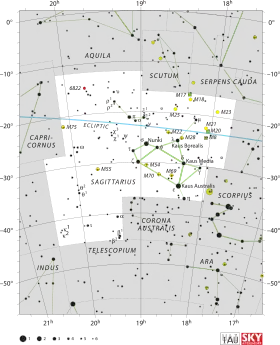Xi2 Sagittarii
Xi2 Sagittarii (ξ2 Sagittarii) is a star in the zodiac constellation of Sagittarius. Data collected during the Hipparcos mission suggests it is an astrometric binary, although nothing is known about the companion.[9][10] It is visible to the naked eye with a combined apparent visual magnitude of +3.51.[2] Based upon an annual parallax shift of 8.93 mas as seen from Earth,[1] this system is located around 370 light years from the Sun.

| |
| Observation data Epoch J2000.0 Equinox J2000.0 (ICRS) | |
|---|---|
| Constellation | Sagittarius |
| Right ascension | 18h 57m 43.79908s[1] |
| Declination | −21° 06′ 23.9613″[1] |
| Apparent magnitude (V) | +3.51[2] |
| Characteristics | |
| Spectral type | G8/K0 II/III[3] |
| U−B color index | +1.13[2] |
| B−V color index | +1.18[2] |
| Astrometry | |
| Radial velocity (Rv) | −20.10[4] km/s |
| Proper motion (μ) | RA: +31.72[1] mas/yr Dec.: −13.33[1] mas/yr |
| Parallax (π) | 8.93 ± 0.53[1] mas |
| Distance | 370 ± 20 ly (112 ± 7 pc) |
| Absolute magnitude (MV) | −1.72[5] |
| Details | |
| Mass | 3.36[4] M☉ |
| Radius | 14[6] R☉ |
| Luminosity | 676[4] L☉ |
| Surface gravity (log g) | 2.23[7] cgs |
| Temperature | 4,541±64[4] K |
| Metallicity [Fe/H] | −0.19[7] dex |
| Age | 380[4] Myr |
| Other designations | |
| Database references | |
| SIMBAD | data |
The spectrum of Xi2 Sagittarii yields a mixed stellar classification of G8/K0 II/III,[3] showing traits of a G- or K-type giant or bright giant star. It has an estimated 3.36[4] times the mass of the Sun and about 14 times the Sun's radius.[6] At an age of around 380 million years, it is radiating 676 times the Sun's luminosity from its photosphere at an effective temperature of 4,541 K.[4]
References
- van Leeuwen, F. (2007), "Validation of the new Hipparcos reduction", Astronomy and Astrophysics, 474 (2): 653–664, arXiv:0708.1752, Bibcode:2007A&A...474..653V, doi:10.1051/0004-6361:20078357.
- Johnson, H. L.; et al. (1966), "UBVRIJKL photometry of the bright stars", Communications of the Lunar and Planetary Laboratory, 4 (99), Bibcode:1966CoLPL...4...99J.
- Houk, Nancy; Smith-Moore, M. (1978), Michigan catalogue of two-dimensional spectral types for the HD stars, 4, Ann Arbor: Dept. of Astronomy, University of Michigan, Bibcode:1988mcts.book.....H.
- Luck, R. Earle (2015), "Abundances in the Local Region. I. G and K Giants", Astronomical Journal, 150 (3), 88, arXiv:1507.01466, Bibcode:2015AJ....150...88L, doi:10.1088/0004-6256/150/3/88.
- Anderson, E.; Francis, Ch. (2012), "XHIP: An extended hipparcos compilation", Astronomy Letters, 38 (5): 331, arXiv:1108.4971, Bibcode:2012AstL...38..331A, doi:10.1134/S1063773712050015.
- Pasinetti Fracassini, L. E.; et al. (2001), "Catalogue of Apparent Diameters and Absolute Radii of Stars (CADARS)", Astronomy & Astrophysics (3rd ed.), 367: 521–24, arXiv:astro-ph/0012289, Bibcode:2001A&A...367..521P, doi:10.1051/0004-6361:20000451.
- McWilliam, Andrew (December 1990), "High-resolution spectroscopic survey of 671 GK giants. I - Stellar atmosphere parameters and abundances", Astrophysical Journal Supplement Series, 74: 1075–1128, Bibcode:1990ApJS...74.1075M, doi:10.1086/191527.
- "ksi02 Sgr". SIMBAD. Centre de données astronomiques de Strasbourg. Retrieved 2017-07-05.
- Frankowski, A.; et al. (March 2007), "Proper-motion binaries in the Hipparcos catalogue. Comparison with radial velocity data", Astronomy and Astrophysics, 464 (1): 377–392, arXiv:astro-ph/0612449, Bibcode:2007A&A...464..377F, doi:10.1051/0004-6361:20065526.
- Makarov, V. V.; Kaplan, G. H. (May 2005), "Statistical Constraints for Astrometric Binaries with Nonlinear Motion", The Astronomical Journal, 129 (5): 2420–2427, Bibcode:2005AJ....129.2420M, doi:10.1086/429590.